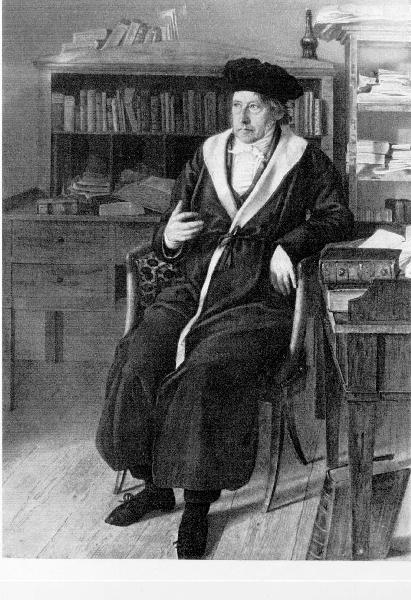
|
Articles Life Phenomenology System Reception Resources Poster+CD Game Info |
| Top FAQ e-Texts Hyptertext Links Discuss Sitemap Email |
G.W.F. Hegel (1770-1831). Aquarell of Hegel at age 58 by Julius L. Sebbers (1804-1837). For more information, see below.

Julius Ludwig Sebbers (who, by the way, immortalised Goethe in 1826) painted Hegel's "Schlafrockbild" in 1828. The original painting (an aquarelle) is the one reproduced above. 1970 (and presumably also now) it was in a private collection. Sebbers painted Hegel "live" (nach der Natur) in his office (Studierstube) at home in Berlin. The "Schlafrock" was Hegel's typical morning dress; the "Barett" is the sign that he belonged to the academic world.
The same Sebbers made a lithography out of his painting in the same year, contributing to spread Hegel's portrait around Germany. There are some slight but evident differences with regard to the aquarelle (The most striking one is that there is no bottle on the right top of the bookshelve in the lithography. Also, the lithography shows the name of Plato on the book on Hegel's table and Aristotle on the book placed on earth, something rather difficult to reproduce in an aquarelle). It has been scientifically established thanks to a research conducted by the Stadtarchiv in Stuttgart, that the lithography was taken out from the painting. While the lithography is signed "L. Sebbers", the aquarelle is unsigned.
The lithographie was probably the first source from where contemporaries all over Germany could learn how Hegel looked like in 1828; Goethe probably mentions this lithography in a letter of 1828, saying that he could not get hold of it, because it was in a lost parcel sent to him from Weimar.
(Many thanks to Maurizio Canfora for providing the information above)
Hotho seems to describes the Hegel on that painting, when he writes in his book 'Vorstudien fur Leben und Kunst':
>>
It was at the beginning of my student-life that one morning I ventured to present myself, shyly, yet full of trust, in Hegel's room. He sat before a broad writing-table, and was impatiently turning over the books and papers which lay heaped in some disorder upon it. His figure was bent in premature age, and yet had a look of native toughness and force; a yellow-gray dressing-gown hung from his shoulders, covering his person down to the ground. There was nothing very noticeable in his general external appearance-no imposing height or charm of manner; rather an impression of a certain honest downrightness, as of some citizen of the olden time, was conveyed in his whole bearing.
The first impression of his face, however, I shall not easily forget. Pale and relaxed, his features hung down as if lifeless; no destructive passion was mirrored in them, but only a long history of patient thought. The agony of doubt, the ferment of unappeasable mental disturbance, seemed never to have tortured, never at least to have overpowered him, in all his forty years of brooding, seeking, and finding; only the restless impulse to develop the early germ of happily discovered truth with ever greater depth and riches-with ever greater strictness of inevitable logic-had furrowed the brow, the cheeks, the mouth. When his mind was slumbering, the features appeared old and withered; when it awoke, they expressed all the earnestness and strength of a thought, which, through the persistent effort of years, had been developed to completeness. What dignity lay in the whole head, in the finely formed nose, the high but somewhat retreating brow, the peaceful chin! The nobleness of good faith and thorough rectitude in great and little, the clear consciousness of having sought satisfaction in truth alone, wag, in the most individual way, imprinted on every feature.
<<
(Translation by Edward Caird in his book 'Hegel')
![]()
Copyright © 1999-2009 by hegel.net, Kai Froeb.
Permission is granted to copy, distribute and/or modify this document under the terms of the GNU Free Documentation License, Version 1.2 or any later version
published by the Free Software Foundation, with no Invariant Sections, with no Front-Cover Texts, and with no Back-Cover Texts. A copy of the license
can be found here: "GNU Free Documentation License".
This work is also licensed under a Creative Commons License.
This work is also licensed under a Creative Commons Developing Nations license.
Questions? Criticism? Want to participate? Send an Email to the webmaster.
Terms of Use Privacy Policy